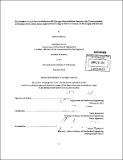The addition of a US Rare Earth Element (REE) supply-demand model improves the characterization and scope of the United States Department of Energy's effort to forecast US REE Supply and Demand
Author(s)
Mancco, Richard
DownloadFull printable version (7.574Mb)
Other Contributors
Massachusetts Institute of Technology. Dept. of Mechanical Engineering.
Advisor
Tonio Buonassisi.
Terms of use
Metadata
Show full item recordAbstract
This paper presents the development of a new US Rare Earth Element (REE) Supply-Demand Model for the explicit forecast of US REE supply and demand in the 2010 to 2025 time period. In the 2010 Department of Energy (DOE) Critical Material Strategy (CMS) report, the DOE created a DOE REE Supply- Demand Model that forecasted world REE supply and demand. Information from the DOE Model was used in the report to gauge future REE supply and demand in the US. The DOE Model only used world REE data for its world supply and demand forecast, discrediting the application and usefulness of a US data driven US REE supply and demand forecast. The new US Model employs US-specific data in the form of new supply factors and demand factors to provide an improved characterization of US REE supply and demand. The US Model's methodology allows for a more precise and direct approach to calculate future REE supply and demand in the US. Four new US-specific REE supply factors were incorporated in the new US Model - global REE competition and non-collaboration, US REE competition from non-clean energy technologies, REE exportation downsizing by REE abundant countries, and new global REE operational mines. Four new US-specific demand factors were incorporated in the new US Model - US government REE information collection capability, US government funded REE research, private industry funded REE research, and other US government REE efforts and policies. The use of these additional factors increased insight of current and possible future US REE conditions than through the use of a world REE forecast alone (DOE Model). This paper recommends the use of the US REE Supply-Demand Model as a supplement to the current DOE Model used in the 2010 DOE CMS report. The value and usefulness of the information made available by the new US Model is analyzed in this paper by experimentally applying the US Model to Indium - a REE utilized in the production of photovoltaic cells.
Description
Thesis (S.B.)--Massachusetts Institute of Technology, Dept. of Mechanical Engineering, 2012. Cataloged from PDF version of thesis. Includes bibliographical references (p. 48).
Date issued
2012Department
Massachusetts Institute of Technology. Department of Mechanical EngineeringPublisher
Massachusetts Institute of Technology
Keywords
Mechanical Engineering.